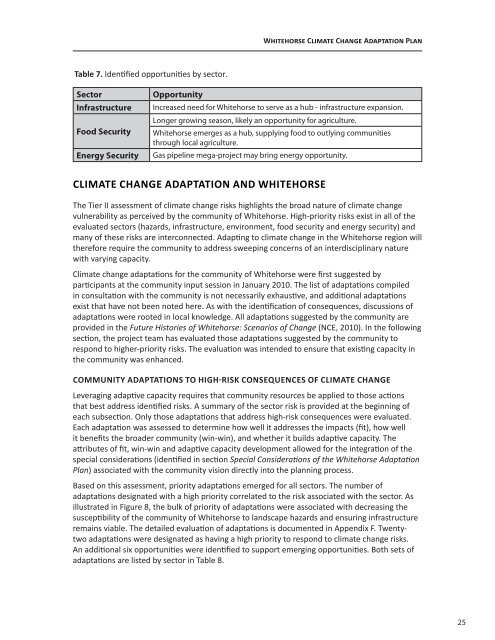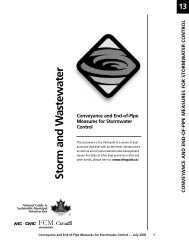Whitehorse Climate Change Adaptation Plan - Yukon College
Whitehorse Climate Change Adaptation Plan - Yukon College
Whitehorse Climate Change Adaptation Plan - Yukon College
Create successful ePaper yourself
Turn your PDF publications into a flip-book with our unique Google optimized e-Paper software.
Table 7. Identified opportunities by sector.<br />
CLIMATE CHANGE ADAPTATION AND WHITEHORSE<br />
<strong>Whitehorse</strong> <strong>Climate</strong> <strong>Change</strong> <strong>Adaptation</strong> <strong>Plan</strong><br />
Sector Opportunity<br />
Infrastructure Increased need for <strong>Whitehorse</strong> to serve as a hub - infrastructure expansion.<br />
Longer growing season, likely an opportunity for agriculture.<br />
Food Security <strong>Whitehorse</strong> emerges as a hub, supplying food to outlying communities<br />
through local agriculture.<br />
Energy Security Gas pipeline mega-project may bring energy opportunity.<br />
The Tier II assessment of climate change risks highlights the broad nature of climate change<br />
vulnerability as perceived by the community of <strong>Whitehorse</strong>. High-priority risks exist in all of the<br />
evaluated sectors (hazards, infrastructure, environment, food security and energy security) and<br />
many of these risks are interconnected. Adapting to climate change in the <strong>Whitehorse</strong> region will<br />
therefore require the community to address sweeping concerns of an interdisciplinary nature<br />
with varying capacity.<br />
<strong>Climate</strong> change adaptations for the community of <strong>Whitehorse</strong> were first suggested by<br />
participants at the community input session in January 2010. The list of adaptations compiled<br />
in consultation with the community is not necessarily exhaustive, and additional adaptations<br />
exist that have not been noted here. As with the identification of consequences, discussions of<br />
adaptations were rooted in local knowledge. All adaptations suggested by the community are<br />
provided in the Future Histories of <strong>Whitehorse</strong>: Scenarios of <strong>Change</strong> (NCE, 2010). In the following<br />
section, the project team has evaluated those adaptations suggested by the community to<br />
respond to higher-priority risks. The evaluation was intended to ensure that existing capacity in<br />
the community was enhanced.<br />
COMMUNITY ADAPTATIONS TO HIGH-RISK CONSEQUENCES OF CLIMATE CHANGE<br />
Leveraging adaptive capacity requires that community resources be applied to those actions<br />
that best address identified risks. A summary of the sector risk is provided at the beginning of<br />
each subsection. Only those adaptations that address high-risk consequences were evaluated.<br />
Each adaptation was assessed to determine how well it addresses the impacts (fit), how well<br />
it benefits the broader community (win-win), and whether it builds adaptive capacity. The<br />
attributes of fit, win-win and adaptive capacity development allowed for the integration of the<br />
special considerations (identified in section Special Considerations of the <strong>Whitehorse</strong> <strong>Adaptation</strong><br />
<strong>Plan</strong>) associated with the community vision directly into the planning process.<br />
Based on this assessment, priority adaptations emerged for all sectors. The number of<br />
adaptations designated with a high priority correlated to the risk associated with the sector. As<br />
illustrated in Figure 8, the bulk of priority of adaptations were associated with decreasing the<br />
susceptibility of the community of <strong>Whitehorse</strong> to landscape hazards and ensuring infrastructure<br />
remains viable. The detailed evaluation of adaptations is documented in Appendix F. Twentytwo<br />
adaptations were designated as having a high priority to respond to climate change risks.<br />
An additional six opportunities were identified to support emerging opportunities. Both sets of<br />
adaptations are listed by sector in Table 8.<br />
25

















